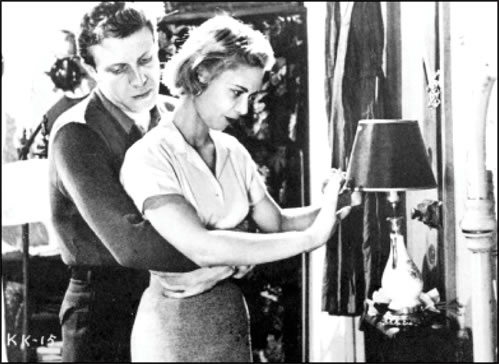By Leonard Quart
Outdoor film series evokes the beauty and underbelly of New York
Movie Nights On The Elevated Acre
Tuesday nights in August
River to River Festival
The Elevated Acre
55 Water St.
Free; RivertoRiverNYC.com
Now in its third season, Movie Nights On The Elevated Acre takes place every Tuesday in August, starting at sundown between 8 p.m. and 9 p.m. The Elevated Acre is a rooftop plaza offering stunning views of the East River, the Brooklyn Heights Esplanade, Red Hook, and the old Ferry Terminal. A seven-leveled concrete amphitheater with a sloping, lushly landscaped garden, the Acre, like the selection of movies screened this summer, is imaginatively conceived.
The curator of the series, video and multimedia designer Tal Yarden, has focused on films dealing with New York. And Yarden makes the viewing experience more inviting by having buskers play before the screening, and providing the audience with free popcorn.
Yarden’s offerings are an appealing mixture of films with mass appeal, like Woody Allen’s “Manhattan,” and experimental, non-narrative shorts that open each evening’s programs. These disparate selections are unified by their urban images and their focus on New York City. This year’s shorts include Nisi Jacobs’ 10-minute “Sugartown”(2001), which will be introduced by the filmmaker on August 5. An abstract and formal film, it centers on the city from the perspective of two women looking at life on the streets through a glazed window. We get glancing views of a billboard, a mailbox covered with graffiti, a church, pedestrians, and cars. Jacobs’ eye focuses more on the patterns she sees, rather than the people or objects. The images are accompanied by a striking sound track filled with street sounds and songs like “Sugartown,” sung by Rita Calypso.
Another short, Adam Cohen’s “Blind Grace” (1993), is a personal street document shot with a hand-held camera that captures the hallucinatory, nocturnal poetry of the city’s desolate streets, and of people walking on subway stairs and through street festivals, and sitting despondently on stoops. The city in “Blind Grace” is pre-gentrification, so the Orchard Street it portrays has no boutiques or luxury towers, just bargain clothing shops and tenements, some of whose windows are boarded up or are mere gaping holes. The screening will also feature a conversation with the filmmaker, Adam Cohen, on August 12.
The feature films include: Stanley Donen and Gene Kelly’s musical, “On the Town” (1949) on August 5; Allen’s “Manhattan” (1979) on August 12; Kubrick’s early, low budget film noir “Killer’s Kiss” (1955) on August 19; and Douglas Sirk’s visually stunning melodrama (pools of expressionist color), “Imitation of Life” (1959) on August 26. “On the Town” turns New York into a magical place for three sailors on 24 -hour leave who meet three single women, and all of them sing and dance with inexhaustible energy and joy. In “Manhattan,” one of Allen’s best films, the city is foregrounded, turning it into a major character. New York becomes an extension of Allen’s protagonists’ personalities — its streets are places to have random and absurd encounters, reflect on both one’s private angst and the city’s plight, and mute or escape one’s anxieties. New York is also a public projection of Allen’s protagonists’ happiest selves and moments — a city of infinite promise and possibility.
In “Killer’s Kiss,” the streets of Manhattan come alive with striking black and white cinematography. Kubrick chooses to tell this story of a l’amour fou with images rather than dialogue. The final chase sequence where the gangster chases the lovers is a thing of beauty.
Douglas Sirk’s last major film, “Imitation of Life,” stars Lana Turner (Lora) as an aspiring actress and single mother who hires a black widowed single mother as a nanny. The nanny has a daughter who attempts to pass for white, and both mothers experience tormented relationships with their respective daughters. Style is always the essence in a Sirk film.
In American film, New York has always been ‘the city’—the place where dreams of success and living a glamorous life are realized, and where corruption, crime and nightmare imagery achieve their apotheosis. New York is not only a city of sharply contrasting imagery, but also a cornucopia of intricate personal and social worlds. The festival presents four of the better films evoking the city, and augments them with original experimental shorts.
.
























